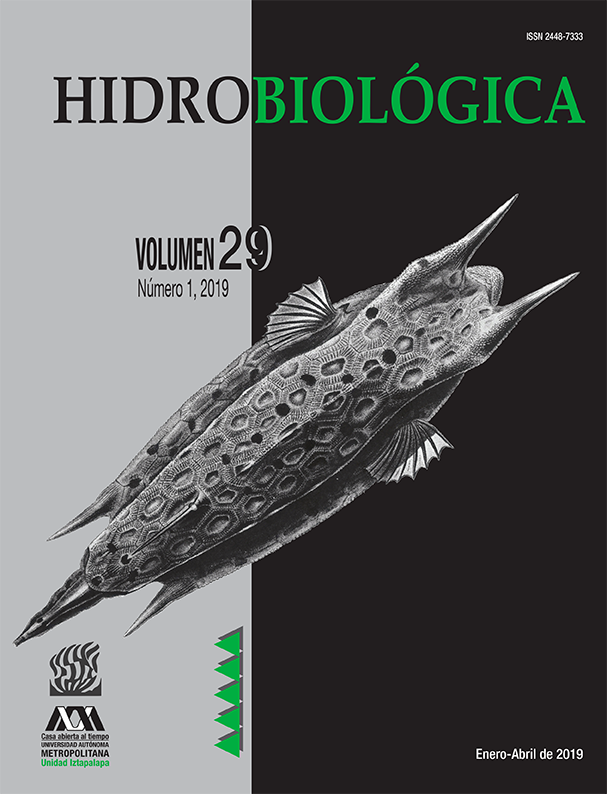Translocation of Chapalichthys encaustus (Actinopterygii: Goodeidae) in the Teuchitlán River, Jalisco, Mexico
DOI:
https://doi.org/10.24275/uam/izt/dcbs/hidro/2019v29n1/MarKeywords:
Anthropization, Central Mexico, introduction of fauna, non-native speciesAbstract
Background and goal. The translocation of the Barred Splitfin Chapalichthys encaustus (Goodeidae) in the Teuchitlán River, located at the headwaters of the Ameca river basin in the center of the state of Jalisco, is reported for the first time. Methods. The fish record was obtained approximately 1 km from the origin of the river. Fish were deposited in the ichthyology collection of the Universidad Michoacana de San Nicolás de Hidalgo (CPUM). Results. On July 17, 2015 an adult female specimen of this species with a total length of 65 mm was collected. The specimen is described and illustrated. In subsequent collections a male specimen of the same species was also obtained. Conclusion. The Barred Splitfin is one of the few documented cases of native translocated ichthyofauna for Mexico and its possible impact on the Teuchitlán River has not been determined.
Downloads
References
Becerra-Muñoz, S., H. R. Buelna-Osben & J. M. Catalán-Romero. 2003. Spatial patterns of ARIMA modeled rates of change of atherinids (Chirostoma spp.) and goodeid Chapalichthys encaustus from Lake Chapala, México. Ecological Modelling 165 (2): 237-250. DOI: 0.1016/S0304-3800(03)00073-5
Blanchet, S., G. Loot, G. Grenouillet & S. Brosse. 2007. Competitive interactions between native and exotic salmonids: a combined field and laboratory demonstration. Ecology of Freshwater Fish 16: 133–143. DOI: 10.1111/j.1600-0633.2006.00205.x
De La Mora-Orozco, C; Flores-López H. E., Durán-Chávez, A. A. 2013. Calidad del agua del embalse de la presa La Vega y su impacto en las tierras agrícolas bajo riego. Libro técnico Núm. 6. INIFAP. 171 p.
Domínguez-Domínguez, O., I. Doadrio & G. Pérez-Ponce de León. 2006. Historical biogeography of some river basins in central Mexico evidenced by their goodeine freshwater fishes: a preliminary hypothesis using secondary Brooks parsimony analysis. Journal of Biogeography 33 (8): 1437-1447. DOI: https://doi.org/10.1111/j.1365-2699.2006.01526.x
Gozlan, R. E., E. J. Peeler, M. Longshaw, S. St-Hilaire & S. W. Feist. 2006. Effect of microbial pathogens on the diversity of aquatic populations, notably in Europe. Microbes and Infection 8: 1358-1364. DOI: https://doi.org/10.1016/j.micinf.2005.12.010
Havel, J. E., K. E. Kovalenko, S. M. Thomaz, S. Amalfitano & L.B. Kats. 205. Aquatic invasive species: challenges for the future. Hydrobiologia 750 (1): 147-170. DOI: 10.1007/s10750-014-2166-0
López López, E. & J. Paulo-Maya. 2001. Changes in the fish assemblages in the upper río Ameca, México. Journal of Freshwater Ecology 16 (2): 179-187. DOI: 10.1080/02705060.2001.9663803
Miller, R. R., W. L. Minckley & S. M. Norris. 2009. Peces dulceacuícolas de México. Comisión Nacional para el Conocimiento y Uso de la Biodiversidad, Sociedad Ictiológica Mexicana A.C., El Colegio de la Frontera Sur, Consejo de los Peces del Desierto, Ciudad de México. 559 p.
Nackley, L. L., A. G. West, A. L. Skowno & W. J. Bond. 2017. The Nebulous Ecology of Native Invasions. Trends in Ecology & Evolution 32 (11): 814-824. DOI: /10.1016/j.tree.2017.08.003
Simberloff, D., L. Souza, M. A. Nuñez, M. N Barrios-Garcia & W. Bunn. 2012. The natives are restless, but not often and mostly when disturbed. Ecology 93 (3): 598-607. DOI: 10.1890/11-1232.1
Soto-Galera, E., E. Díaz-Pardo, E. López-López & J. Lyons.1998. Fish as indicators of environmental quality in Río Lerma Basin, México. Aquatic Ecosystem Health Manage 1: 267– 276. DOI: 10.1016/S1463-4988(98)00012-8
Webb, S. A. & R. R. Miller. 1998. Zoogoneticus tequila, a new goodeid fish (Cyprinodontiformes) from the Ameca drainage of Mexico, and a rediagnosis of the genus. Occasional Papers of the Museum of Zoology the University of Michigan 725: 1-23.
Weyl, O. L. F. & H. Lewis. 2006. First record of predation by the alien invasive freshwater fish Micropterus salmoides L. (Centrarchidae) on migrating estuarine fishes in South Africa. African Zoology 41: 294-296. DOI: 10.1080/15627020.2006.11407365
Downloads
Published
How to Cite
Issue
Section
License
Los autores/as que publiquen en esta revista aceptan las siguientes condiciones:
De acuerdo con la legislación de derechos de autor, HIDROBIOLÓGICA reconoce y respeta el derecho moral de los autores, así como la titularidad del derecho patrimonial, el cual será cedido a la revista para su difusión en acceso abierto.
Publicar en la revista HIDROBIOLÓGICA tiene un costo de recuperación de $500 pesos mexicanos por página en blanco y negro (aproximadamente 29 dólares americanos) y $1000 pesos por página a color (aproximadamente 58 dólares americanos).
Todos los textos publicados por HIDROBIOLÓGICA sin excepción se distribuyen amparados bajo la licencia Creative Commons 4.0Atribución-No Comercial (CC BY-NC 4.0 Internacional), que permite a terceros utilizar lo publicado siempre que mencionen la autoría del trabajo y a la primera publicación en esta revista.
Los autores/as pueden realizar otros acuerdos contractuales independientes y adicionales para la distribución no exclusiva de la versión del artículo publicado en HIDROBIOLÓGICA (por ejemplo incluirlo en un repositorio institucional o publicarlo en un libro) siempre que indiquen claramente que el trabajo se publicó por primera vez en HIDROBIOLÓGICA.
Para todo lo anterior, el o los autor(es) deben remitir el formato de Carta-Cesión de la Propiedad de los Derechos de la primera publicación debidamente requisitado y firmado por el autor(es). Este formato se puede enviar por correo electrónico en archivo pdf al correo: enlacerebvistahidrobiológica@gmail.com; rehb@xanum.uam.mx (Carta-Cesión de Propiedad de Derechos de Autor).
Esta obra está bajo una licencia de Creative Commons Reconocimiento-No Comercial 4.0 Internacional.


